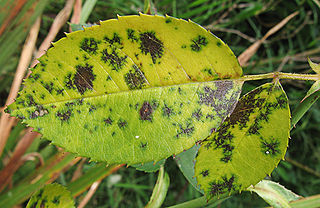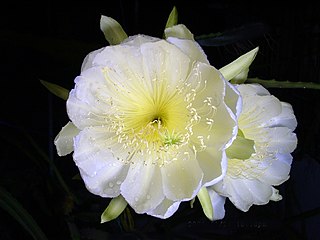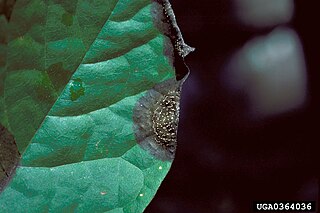
Botrytis cinerea is a necrotrophic fungus that affects many plant species, although its most notable hosts may be wine grapes. In viticulture, it is commonly known as "botrytis bunch rot"; in horticulture, it is usually called "grey mould" or "gray mold".

Selenicereus undatus, the white-fleshed pitahaya, is a species of Cactaceae and is the most cultivated species in the genus. It is used both as an ornamental vine and as a fruit crop - the pitahaya or dragon fruit. The native origin of the species has never been resolved.

Diplocarpon rosae is a fungus that creates the rose black spot disease. Because it was observed by people of various countries around the same time, the nomenclature for the fungus varied with about 25 different names. The asexual stage is now known to be Marssonina rosae, while the sexual and most common stage is known as Diplocarpon rosae.

Hylocereus megalanthus is a cactus species in the genus Hylocereus that is native to northern South America, where it is known, along with its fruit, by the name of Pitahaya. The species is grown commercially for its yellow fruit, but is also an impressive ornamental climbing vine with perhaps the largest flowers of all cacti.

Rhizoctonia solani is a plant pathogenic fungus with a wide host range and worldwide distribution. It was discovered more than 100 years ago. R. solani frequently exists as thread-like growth on plants or in culture, and is considered a soil-borne pathogen. R. solani is best known to cause various plant diseases such as collar rot, root rot, damping off, and wire stem. R. solani attacks its hosts when they are in their early stages of development, such as seeds and seedlings, which are typically found in the soil. The pathogen is known to cause serious plant losses by attacking primarily the roots and lower stems of plants. Although it has a wide range of hosts, its main targets are herbaceous plants. R. solani is a basidiomycete fungus but the teleomorph stage is not prominent. Occasionally, sexual spores (basidiospores) are produced on infected plants. The disease cycle of R. solani is important in management and control of the pathogen. The pathogen is not currently known to produce any asexual spores (conidia), though it is considered to have an asexual lifecycle perpetuated through sclerotia.

Colletotrichum acutatum is a plant pathogen. It is the organism that causes the most destructive fungal disease, anthracnose, of lupin species worldwide. It also causes the disease postbloom fruit drop on many varieties of citrus, especially Valencia and navel oranges in Florida.
Alternaria citri is a fungal plant pathogen.

Alternaria solani is a fungal pathogen that produces a disease in tomato and potato plants called early blight. The pathogen produces distinctive "bullseye" patterned leaf spots and can also cause stem lesions and fruit rot on tomato and tuber blight on potato. Despite the name "early," foliar symptoms usually occur on older leaves. If uncontrolled, early blight can cause significant yield reductions. Primary methods of controlling this disease include preventing long periods of wetness on leaf surfaces and applying fungicides.

Cochliobolus carbonum is one of more than 40 species of filamentous ascomycetes belonging to the genus Cochliobolus. This pathogen has a worldwide distribution, with reports from Australia, Brazil, Cambodia, Canada, China, Congo, Denmark, Egypt, India, Kenya, New Zealand, Nigeria, Solomon Islands, and the United States. Cochliobolus carbonum is one of the most aggressive members of this genus infecting sorghum, corn and apple. As one of the most devastating pathogens of sweet corn, C. carbonum causes Northern leaf spot and ear rot disease while the asexual stage causes Helminthosporium corn leaf spot. Cochliobolus carbonum is pathogenic to all organs of the corn plant including root, stalk, ear, kernel, and sheath. However, symptoms of infection show distinct manifestations in different plant parts: whole plant - seedling blight affects the whole plant, leaf discoloration and mycelial growth, black fungal spores and lesions appear on inflorescences and glumes, and grain covered with very dark brown to black mycelium which gives a characteristic charcoal appearance due to the production of conidia.

Phomopsis obscurans is a common fungus found in strawberry plants, which causes the disease of leaf blight. Common symptoms caused by the pathogen begin as small circular reddish-purple spots and enlarge to form V-shaped lesions that follow the vasculature of the plant’s leaves. Although the fungus infects leaves early in the growing season when the plants are beginning to develop, leaf blight symptoms are most apparent on older plants towards the end of the growing season. The disease can weaken strawberry plants through the destruction of foliage, which results in reduced yields. In years highly favorable for disease development, leaf blight can ultimately lead to the death of the strawberry plants. A favorable environment for the growth and development of the Phomopsis obscurans pathogen is that of high temperature, high inoculum density, a long period of exposure to moisture, and immature host tissue. In the case of disease management, a conjunction of cultural practices is the most effective way of reducing the infection.

Didymella bryoniae, syn. Mycosphaerella melonis, is an ascomycete fungal plant pathogen that causes Gummy stem blight on the family Cucurbitaceae [1-3]. The anamorph/asexual stage for this fungus is called Phoma cucurbitacearum[2]. This pathogen commonly affects the foliage and stems of plants from the family Cucurbitaceae, which includes cantaloupe, cucumber, muskmelon and watermelon plants [1,3,8]. When this pathogen infects the fruit of cucurbits it is called black rot [2].

Colletotrichum coccodes is a plant pathogen, which causes anthracnose on tomato and black dot disease of potato. Fungi survive on crop debris and disease emergence is favored by warm temperatures and wet weather.
Phialophora gregata is a Deuteromycete fungus that is a plant pathogen which causes the disease commonly known as "brown stem rot of soybean. P. gregata does not produce survival structures, but has the ability to overwinter as mycelium in decaying soybean residue.

A pitaya or pitahaya is the fruit of several different cactus species indigenous to the Americas. Pitaya usually refers to fruit of the genus Stenocereus, while pitahaya or dragon fruit refers to fruit of the genus Hylocereus, both in the family Cactaceae. Dragon fruit is cultivated in Southeast Asia, India, United States, the Caribbean, Australia, Mesoamerica and throughout tropical and subtropical world regions.
Pineapple black rot, also known as butt rot, base rot, or white blister, is a disease caused by Ceratocystis paradoxa (teleomorph). C. paradoxa also causes disease in a variety of other tropical plants such as banana, coconut, and sugarcane making it a somewhat dangerous pathogen. Pineapple black rot is the most common and well-known post-harvest disease of the pineapple fruit and is responsible for serious losses in the fresh pineapple fruit world industry. The pathogen is a polyphagous wound parasite and gains entry into the fruit via wounds sustained during and after harvest. The disease only shows up in fresh fruit because the time from harvest to processing it too short for infection occur. Infection can also occur out in the field, but it is not nearly as common as post-harvest infection.

Heterobasidion irregulare is a tree root rotting pathogenic fungus that belongs to the genus Heterobasidion, which includes important pathogens of conifers and other woody plants. It has a wide host and geographic range throughout North America and causes considerable economic damage in pine plantations in the United States. This fungus is also a serious worry in eastern Canada. Heterobasidion irregulare has been introduced to Italy (Lazio)(modifica) where it has been responsible for extensive tree mortality of stone pine. Due to the ecology, disease type, host range/preference, interfertility group, and genetic information, H. irregulare was designated a new species and distinguished from Heterobasidion occidentale.

Ascochyta blights occur throughout the world and can be of significant economic importance. Three fungi contribute to the ascochyta blight disease complex of pea. Ascochyta pinodes causes Mycosphaerella blight. Ascochyta pinodella causes Ascochyta foot rot, and Ascochyta pisi causes Ascochyta blight and pod spot. Of the three fungi, Ascochyta pinodes is of the most importance. These diseases are conducive under wet and humid conditions and can cause a yield loss of up to fifty percent if left uncontrolled. The best method to control ascochyta blights of pea is to reduce the amount of primary inoculum through sanitation, crop-rotation, and altering the sowing date. Other methods—chemical control, biological control, and development of resistant varieties—may also be used to effectively control ascochyta diseases.

Southern corn leaf blight (SCLB) is a fungal disease of maize caused by the plant pathogen Bipolaris maydis.
Raspberry leaf spot is a plant disease caused by Sphaerulina rubi, an ascomycete fungus. Early symptoms of infection are dark green spots on young leaves. As the disease progresses, these spots turn tan or gray in color. Disease management strategies for raspberry leaf spot include the use of genetically resistant raspberry plant varieties, chemical fungicide sprays, and cultural practices such as pruning and thinning out canes.
Gummy Stem Blight is a cucurbit-rot disease caused by the fungal plant pathogen Didymella bryoniae . Gummy Stem Blight can affect a host at any stage of growth in its development and affects all parts of the host including leaves, stems and fruits. Symptoms generally consist of circular dark tan lesions that blight the leaf, water soaked leaves, stem cankers, and gummy brown ooze that exudes from cankers, giving it the name Gummy Stem Blight. Gummy Stem Blight reduces yields of edible cucurbits by devastating the vines and leaves and rotting the fruits. There are various methods to control Gummy Stem Blight, including use of treated seed, crop rotation, using preventative fungicides, eradication of diseased material, and deep plowing previous debris.













